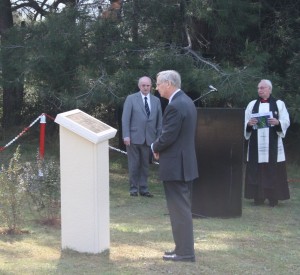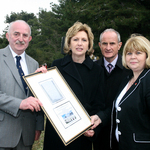On Tuesday, 23rd and Wednesday 24th March, 2010, following Turkish Victory Day on 18th March and as part of a Pilgrimage to the Dardanelles to commemorate the 95th Anniversary of the Gallipoli Campaign (Çanakkale Savaşlari), the Somme Association held two unique Services of Remembrance for the 10th (Irish) Division in the First World War. On August 9th this year, with senior colleagues from the Somme Association and the Chairman of Dalaradia, Robert Williamson, I attended A Service of Commemoration to mark the centenary of the Campaign in Christchirch Cathedral, Lisburn.
The Gallipoli Campaign was initiated on 25th April 1915 (ANZAC Day) and lasted until 9th January 1916, with the British objective of capturing the Ottoman Capital of Istanbul and relieve Russia. It was badly organised and resulted in a Turkish victory but losses on both sides were enormous due to the exceptional fighting abilities of the opposing armies. Half a million men fought in each and casualties for both were a quarter of a million men.
Following the failure of the Anglo-French naval force to drive a passage through the Dardanelles in order to capture Istanbul, the allies decided to capture the Turkish forts overlooking the straits by a land invasion. At dawn on 25th April 1915, troops of the Mediterranean Expeditionary Force landed on the Gallipoli peninsula. The plan was for the 29th Division and the Royal Navy Division to advance rapidly north from Cape Helles, and for the Australians and New Zealanders (ANZAC) to land on the west coast with the intention of crossing the peninsula and so preventing Turkish reinforcements from moving south.
The landings at Cape Helles did not go well because of strong Turkish resistance, the Ottoman Imperial forces including Kurds and Armenians, and the initial targets of the village of Krithia and the high ground of Achi Baba were never achieved. The Australians and New Zealanders fared little better. Because the Royal Navy commanders had underestimated the effect of the tidal current on the west coast, they were landed some 2,000 metres north of their proposed landing place and came under intense fire from the Turkish defenders.
After three months of bitter fighting the allies at Cape Helles had made little headway against determined opposition, while the ANSAC were pinned down by a series of of Turkish attacke, augmented by constant accurate sniper fire, one famously by a woman soldier. The British Government reluctantly decided to break the stalemate by making a fresh landing at Suvla Bay using the 9th Army Corps.. The 10th (Irish) Division was in this force and it included units from all the Irish infantry regiments. They made an opposed landing at Suvla Bay in early August.
Immediately prior to this attack the Australians and New Zealanders made a determined attack to capture the high ground at Chunuk Blair. The Wellington Battalion captured this high ground and held it for 48 hours before being overwhelmed by a Turkish counter-attack. The New Zealand attackers were the only troops of the entire force who caught sight of their ultimate objective – the Dardanelles – whilst holding Chunuk Blair.
The Gallipoli Campaign resounded profoundly on all nations. In both Turkey and Ireland it was a defining moment in history and laid the foundations of the Turkish and Irish Wars of Independence. For Turkey it meant the rise of the great military commander, Kemal Atatürk, who fought here and is justly considered the Father of the Turkish Nation. It was also the first major battle of the Australian and New Zealand Army Corps (ANZAC) and marks the birth of national consciousness in both countries.
 On 23rd March at Green Hill Cemetery, Gallipoli, the Somme Association’s President , His Royal Highness The Duke of Gloucester, KG, GCVO in the presence of Civic Dignitaries and Old Comrades’ Associations from throughout Ireland laid a single wreath to the memory of all those who fought in the Gallipoli Campaign. He then planted and dedicated four Myrtle trees, one for each of the Provinces of Ireland from which they came, to the 12,000 Volunteers of the 10th (Irish) Division, of whom more than 4,000 lost their lives. Throughout the Mediterranean World the Myrtle is a symbol of Love and Immortality, its scent the scent of Paradise. The area would henceforth be known as the Duke of Gloucester’s Grove. Following this, His Royal Highness unveiled the Association’s Memorial to the former combatants.
On 23rd March at Green Hill Cemetery, Gallipoli, the Somme Association’s President , His Royal Highness The Duke of Gloucester, KG, GCVO in the presence of Civic Dignitaries and Old Comrades’ Associations from throughout Ireland laid a single wreath to the memory of all those who fought in the Gallipoli Campaign. He then planted and dedicated four Myrtle trees, one for each of the Provinces of Ireland from which they came, to the 12,000 Volunteers of the 10th (Irish) Division, of whom more than 4,000 lost their lives. Throughout the Mediterranean World the Myrtle is a symbol of Love and Immortality, its scent the scent of Paradise. The area would henceforth be known as the Duke of Gloucester’s Grove. Following this, His Royal Highness unveiled the Association’s Memorial to the former combatants.
On 24th March at Green Hill Cemetery, Gallipoli, a second Service of Remembrance was held in the presence of Her Excellency, Mary McAleese, President of Ireland. Her Excellency dedicated a plaque to the memory of the individual Regiments who formed the 10th (Irish) Division, their Comrades-in-Arms and their brave Turkish adversaries. The nine Regiments were the Royal Irish Regiment, the Royal Inniskillen Fusiliers, the Royal Irish Rifles, the Royal Irish Fusiliers, the Connaught Rangers, the Leinster Regiment, the Royal Munster Fusiliers, the Royal Dublin Fusiliers and the Hampshire Regiment.
 Speaking at the events, as the Chairman of the Somme Association, I said that I was delighted that both HRH The Duke of Gloucester and Her Excellency the President of Ireland had accepted the invitation to attend the ceremonies. The Duke, as quondam Earl of Ulster, had agreed to follow his late mother, The Princess Alice, as President of the Somme Association, and he was Colonel-in-Chief of the Royal Anglian Regiment, the Royal Army Medical Corps, and the Royal New Zealand Army Medical Corps, a true ANZAC. Princess Alice was fondly remembered in Northern Ireland because of her visit there following the Befast Blitz of 1941. President McAleese was well known for her work in bringing the two communities in Northern Ireland closer together, particularly through the establishment of the Irish Tower at Messines in Belgium. In attending this ceremony in Gallipoli she had proved herself to be a truly great President of Ireland.
Speaking at the events, as the Chairman of the Somme Association, I said that I was delighted that both HRH The Duke of Gloucester and Her Excellency the President of Ireland had accepted the invitation to attend the ceremonies. The Duke, as quondam Earl of Ulster, had agreed to follow his late mother, The Princess Alice, as President of the Somme Association, and he was Colonel-in-Chief of the Royal Anglian Regiment, the Royal Army Medical Corps, and the Royal New Zealand Army Medical Corps, a true ANZAC. Princess Alice was fondly remembered in Northern Ireland because of her visit there following the Befast Blitz of 1941. President McAleese was well known for her work in bringing the two communities in Northern Ireland closer together, particularly through the establishment of the Irish Tower at Messines in Belgium. In attending this ceremony in Gallipoli she had proved herself to be a truly great President of Ireland.
I quoted the famous statement of Kemal Atatürk in 1935 to the mothers of the Allied soldiers:
“Uzak memleketin topraklari üstünde kanlarini döken kahramanlar:
Burada dost bir vatanin toprağindasiniz.
Huzur ve sükun içinde uyuyunuz.
Sizler Mehmetçiklerle yan yana, koyun koyunasiniz.
Uzak diyarlardan evlatlarini harbe gönderen analar;
Gözyaşlarinizi dindiriniz, evlatlarini,bizim bağrimizdadir.
Huzur içinde rahat rahat uyuyacaklardir.
Bu toprakta verdikten sonra artik bizim evlatlarimiz olmşlardir.”
“Heroes who shed their blood and lost their lives…
You are now lying in the soil of a friendly country- therefore rest in peace.
You lie side by side here in this country of ours with Turkish soldiers…
You, the mothers, who sent their sons
from far away countries, wipe away your tears;
your sons are now lying in our bosom and will rest in peace.
After having lost their lives on this land
They have become our sons as well…!
Echoing the words of the former President of Turkey, Süleyman Demirel, 15 years previously, when the Somme Association first came to Gallipoli I went on:
“Bir zamanlar birbirine karşi savaşirken
Hayatlarini kaybetmiş yüzbinlerce genç insan
Topraklarimizda; Gelibolu Yarimadasi’nda
Mehmetçiklerle kucak kucağa kefensiz yatmaktadirlar.
Bu ibret ve hüzün dolu tablo insanliğa
‘Barişin değerini bilin’ diyor.
Ne mutlu anlayana;
Ne mutlu Insanlik ve Bariş için canlarini feda edenlere…”
” Hundreds of thousands of young men fought and gave their lives here in the Gallipoli Peninsula. It presents a picture of sadness beyond belief. So we must tell the world that they must appreciate Peace so that these men will not have lost their lives in vain “.
I finished by addressing the 10th (Irish) Division itself.
To the sons of Ulster and to the sons of Ireland we say:-
“Sons of Ulster, soldiers of Ireland. Do not be anxious. The War is over – both here and in your beloved Ireland. The Western Front is no more and Ireland, at last, is at peace with herself and with her people. But we will always remember you, so long as the sun shines and the rain falls and the wind blows on Suvla Bay”
And in Ulster Gaelic:
Inniu, deir muid le fir Uladh agus le fir na hÉireann:-
“A Fheara Uladh agus a Shaighdiúiri na hÉireann, ná biodh imni oraibh. Tá an Cogadh thart-ni amháin san áit seo, ch in bhur dtír dhílis féin in Éirinn. Níl an Fronta Thiar ann níos mó, agus, sa deireadh, tá tír na hÉireann fàoi shíocháin léi féin agus len a pobal.
Ach cuimhneochaidh muid oraibh go deo, fhad is a shoilsíonn an ghrian agus a thiteann an fhearthainn agus fhad is a shéideann an ghaoth ar Bháigh Suvla”
In September 1915, when the Suvla front became a stalemate, the division was moved to Salonika where it remained for two years and fought the Battle of Kosturino. At Salonika was erected the 10th (Irish) Division Memorial cross, visited by our Somme Association manager Billy Ervine.
The division moved to Egypt in September 1917 where it joined General Chetwode’s XX Corps. It fought in the Third Battle of Gaza which succeeded in breaking the resistance of the Turkish defenders in southern Palestine.